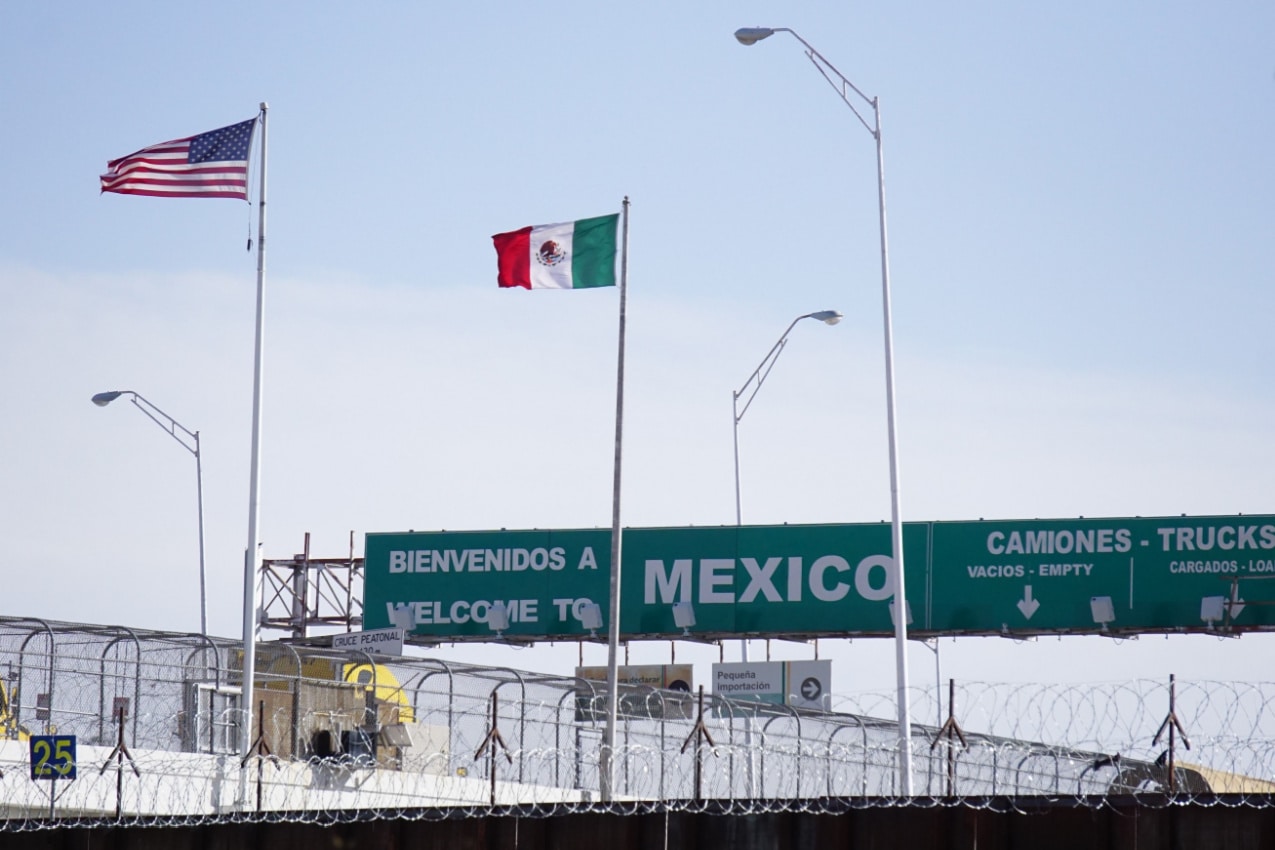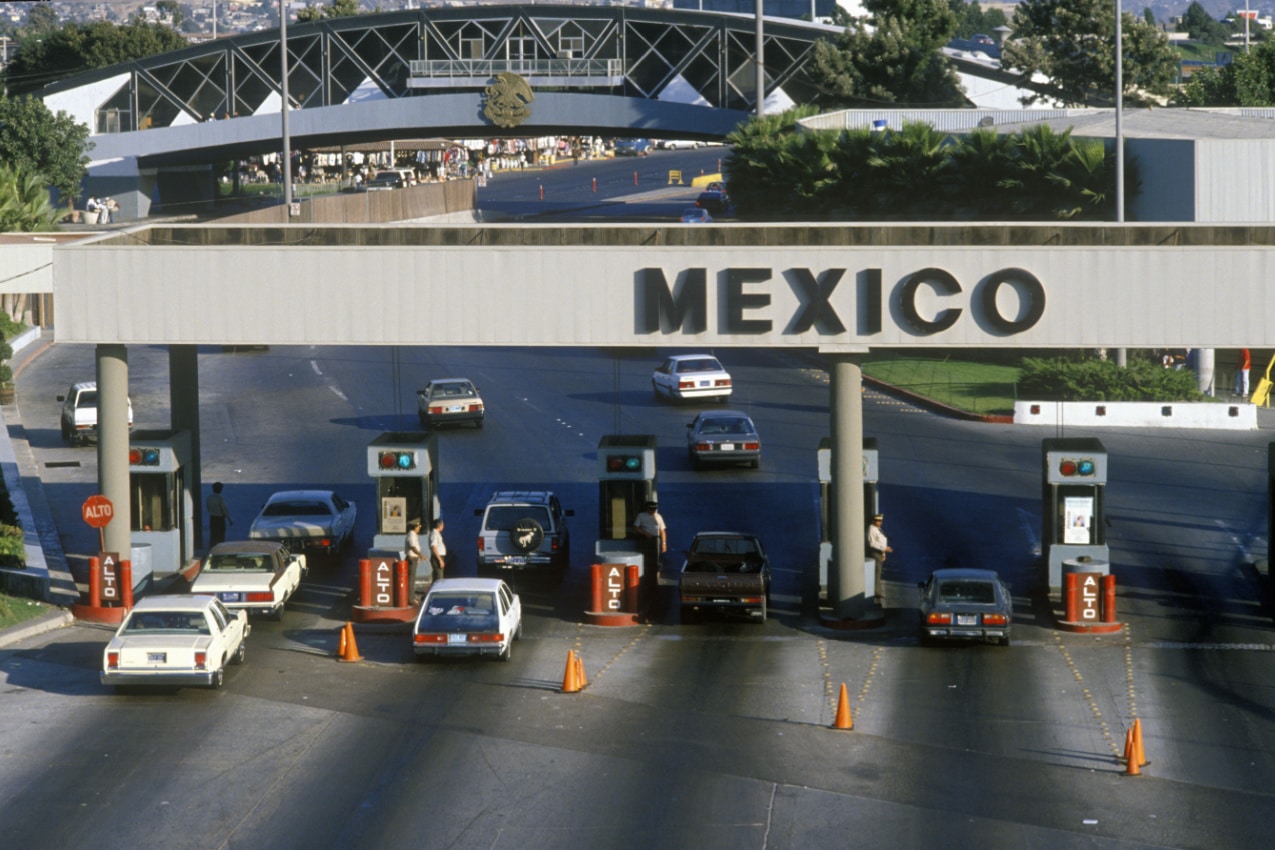No other form of transport gives you the freedom of the road the way traveling by car does. Whether it’s your own car or a rental, you get flexibility like no other, with enough storage space for all the tequila and local craft beer you want to bring back home, vinyl of local music you bought on a whim, and will never listen to, and, most importantly, the opportunity to roam free without sticking to an arbitrary schedule.
That’s the case for those who want to travel to Mexico from the United States since it’s easy to cross the border – at least when you’re going that way. Even if you’re visiting from elsewhere – Europe, Asia, Australia, etc. – you can still rent a car from Mexico or the States.
However, despite the freedom and peace of mind it’ll give you when traveling, driving in another country requires a bit of preparation and lots of knowledge. The preparation part includes documents that you didn’t know you needed and the knowledge part refers to what you need to know about the place you’re planning to drive around – in this case, Mexico.
Read on to get a document checklist and all the information you need when driving in Mexico – how to stay safe, places to avoid, and how it differs from driving in other places, like the US.
Document Checklist

Whether you’re crossing the border with your own car or planning to rent a car once you’re in Mexico, you need the same documents.
Passport (Identification)
Maybe it’s a bit too obvious, but that’s why some of us easily overlook it. Whenever you want to travel abroad, you need to have your passport with you.
When traveling to Mexico, a PASS card, also known as passport card (which is available to everyone) is also valid. In the case of United States citizens, an Enhanced Driver’s License can replace a passport.
Members of Native American tribes can use their Enhanced Tribal Cards, Native American Tribal Photo Identification Card, or Form I-872 American Indian Card to cross the borders between Canada, the United States, and Mexico.
Members of the US Military can just show their military ID if they have military traveling orders. If you’re a marine merchant in the official maritime business, a U.S. Merchant Mariner Credential will suffice for you.
Note that birth certificates or photo IDs issued by the government won’t allow you to travel abroad – not to Mexico, not to Canada.
Driving License
Another no-brainer, a driving license is a must for driving in Mexico. The Mexican authorities accept almost all driving licenses issued in other countries, including the United States, United Kingdom, Canada, and Australia.
However, if your driving license isn’t printed in English or Spanish, you need an International Driving Permit. You can do it easily by following the instructions in the link we supplied.
If you want to settle in Mexico or plan on traveling to Mexico frequently, you might apply for a Mexican driving license, too. The procedure requires:
- A fee of 43 US dollars
- Passport
- Confirmation of your residential address
- Eye test
- Blood type verification
- A practical driving test
- A Theoretical Test regarding traffic rules and regulations in Mexico
Vehicle Registration Document
You need to have your vehicle registration document with you even when you’re just driving to Walmart to pick up some Mexican IPA. So, you need to have it in the car when you’re crossing the Mexican border to relish that beer in its natural habitat.
Mexican Immigration Card
Mexico mandates all tourists, no matter which foreign country they’re visiting, to have a Mexican immigration card, also referred to as the Official Entry Immigration Form. It’s a must for anyone over the age of two, so if you’re traveling with your family, don’t think that your kids are exempt from this rule.
The best way to acquire it is to fill out an online form; otherwise, you’ll wait a while to fill it out physically when crossing the border.
Please note that you can’t fill out a physical copy of this form when you’re entering Mexico via a commercial airline.
Recently, it’s been on the news that the officers at the Cancun Airport couldn’t handle all the incoming tourists who didn’t fill their immigration forms online. It resulted in a queue where some waited for more than two hours to fill out the form at the airport.
Consequently, the authorities scrapped the practice from the Cancun Airport, allowing fast entry for American citizens only. However, other countries citizens and those who are going to land at another airport still need to get the card online.
Car Insurance Policy
If you’re driving around in Mexico with your own car, your American (or Australian or British, etc.) car insurance policy won’t cover you in case of accidents – like if you cause injury to others or damage to others’ properties. So, you need a Mexican car insurance policy, i.e., civil liability insurance.
If you don’t have that document and still cause damage to others’ properties, and the authorities deem it to be your fault, you are expected to pay the cost of the damage you caused right there on the crash scene. Otherwise, you’re likely to go to jail and stay there until somebody benevolent in your social circle throws some money at the problem. If it’s not your fault (according to the authorities), you’ll likely remain free.
Should you hurt yourself in a wreck but not harm others, you’re not going to jail, and in such cases, your American insurance policy might cover you, but that depends on the carrier. It’s best to consult your carrier before your trip to Mexico regarding their rule of conduct in Mexico.
Still, we don’t advise relying only on what your American insurance may or may not cover and recommend that you get Mexican civil liability insurance before your trip. You can get a quote from the following insurance companies based on how long your trip is going to take:
- Allstate – Mexico Car Insurance for Tourists
- Baja Mex – Buy Insurance for Driving in Mexico
- Geico – Car Insurance for Mexico (Tourists)
- MexInsurance – Auto Insurance
- MexPro – Mexico Tourist Auto Insurance for U.S. and Canadian Plated Vehicles
Additionally, if you’re going to rent a car, big car rental companies such as RentalCars.com act as intermediaries between you and insurance providers. Make sure you consult them.
Temporary Vehicle Importation Permit
When you’re driving through the Mexican border from the United States in your car, it means that you’re importing your car to Mexico even if it’s just for a couple of days. And for that, you need a temporary permit for importing your vehicle.
You can get this permit online with a valid US passport and your vehicle registration document, or in person from the Mexican consulate in Denver. In either case, you need to remember the following:
- You need to apply 7 to 60 days before your scheduled trip. Otherwise, it won’t be valid.
- When you pay for it with your credit card, it costs you 21 USD. If you don’t have a credit card, you’ll need to pay extra for a bond and processing fee.
- You need to pay a warranty deposit, which will be reimbursed to your card once your car is back in its country of origin. For year-2000 car models or older, the deposit is $200; for 2000-to-2006 car models, it’s $300; and for car models from 2007 or later, it’s $400.
- The temporary vehicle importation permit for driving in Mexico provides coverage for only six months (180 days). You need to renew it once it expires.
- It’s best to keep it on your windshield when you’re crossing the border and driving around Mexico. That way, you’re less likely to engage with local law enforcement officers.
Requirements for Renting a Car in Mexico
You might travel to Mexico by sea or air and then rent a car to make the rest of your trip as flexible and free as possible.
Here’s what you need to know regarding car rentals in Mexico:
- You need to have a valid driving license for at least two more years.
- You need to be older than 25 to rent a car in Mexico.
- You should carry proof of civil liability insurance, also referred to as car insurance, acquired from a Mexican insurance provider. If you’re renting your car via RentalCars, they’ll make sure you have one.
- You can only use a credit card to pay the car rent and other potential incidental costs. The car rentals in Mexico don’t accept debit cards.
- Before driving away in your rental car, examine the car thoroughly with your rental agent and have the agent note down every scratch and problematic car component while also photographing these scratches, etc. That way, the rental company won’t be able to blame you for something you haven’t done.
Driving Through the Mexican Border From the United States

The drive from the United States to Mexico should be an easy one, but there are still a few things that you need to heed:
- The border states of Mexico are a hotspot for cartels that want to smuggle drugs and people into the United States. The cartel activity in the area reaches its peak during the night, and albeit rarely, these activities might include the kidnapping of tourists. So, we recommend that you time your passage in the early morning. That way, you can reach your first stop in Mexico in daylight and avoid danger as best you can.
- There are several lanes on the border in which cars drive slowly and get checked through cameras and by border guards. All these lanes have traffic lights above: red light means stop and head to the inspection area, and green light means pass and go right through to Mexico. But there is a small element of surprise. If you comply with all the requirements listed above, it’s likely that the light on your lane will flicker green. However, there’s still a chance that it turns red, in which case Mexican customs officials and border guards will inspect your documents and your car thoroughly.
Now, the scenario in which your car is stopped might get interesting, and if you’ve never had anyone around you who had a trip to Mexico by car, you might be surprised by what you are and aren’t allowed to carry across the border.
Prohibited Items to Carry From the United States to Mexico
There’s a lengthy list of items you can’t carry from the United States to Mexico, barring the usual suspects such as illegal drugs, people, a vandalized piece of the Statue of Liberty, or the skull of an extraterrestrial that NASA has uncovered from an interstellar crash site.
- In the United States, we might be used to the sight of guns because they’re legal and easy to access in most states, but that’s not the case in Mexico – that is if you’re not a member of a cartel that bribes the federal police and military on a regular basis. In Mexico, guns are illegal, and you’ll be immediately arrested for carrying one. The same goes for ammunition – you’re not allowed to pack ammo on your drive through the Mexican border.
- Guns aren’t the only lethal items that are forbidden for tourists to carry across the border. You can’t have lethal knives, machetes, or switchblades in your car.
- Now we’re really getting into serious territory because guns and blades aren’t the only lethal items on Earth. There are predatory fish species like sharks, barracuda, perch, and salmon, some of which are pretty lethal, and you can’t have a live predatory fish in your car on your way to Mexico. There are enough sharks and shark species in the Gulf of Mexico anyway, so pick one from there if you’re in dire need.
- Totoaba fish is a species exclusive to the Sea of Cortez, a sea located in the Baja California peninsula of Mexico. Fresh, frozen, or live, you can’t have a totoaba fish in your car while driving through the border (or within Mexico) because this unique and rare species is under threat of extinction.
- In the same vein, it’s forbidden to have turtle eggs, turtle skin, or loggerhead turtles in your car.
- You must declare all agricultural products (including the most basic ones such as oranges and apples), medicines, and animals beforehand to the Mexican customs authority. If you can’t prove that they’re for personal enjoyment, you’ll be denied entry.
- It’s not only illegal drugs that are forbidden to carry when driving through the Mexican border – but also the seeds and chemical material that may be used in cultivating or making drugs. The list is an extensive one – from poppy seeds or poppy flour (used for producing opium) to, rather more obviously, marijuana seeds, extracts, and even medical marijuana.
- You can’t take thallium sulfate or insecticides (namely, Isodrin, Aldrin, Heptachlor, Drinox, Endrin, Mendrin, Nendrin, Hexadrin, or Leptophos) to Mexico. You can have OTC insect repellents that are sold in markets and pharmacies. Actually, we recommend that you always have insect-repellent on you to avoid insect-borne diseases.
- Other sets of chemicals that are forbidden to take to Mexico are medicines that contain acetylmorphine or its derivatives.
- You can carry a rubber band speargun, but not an air compression speargun to Mexico.
- You’re over 40, want to move to Mexico, and have Garbage Pail Kids trading cards in your baggage? Well, in that case, you can’t enter Mexico. In 1988, the Mexican state prohibited the representation of children “in a degrading or ridiculous manner, in attitudes of incitement to violence, self-destruction or in any other form of antisocial behavior,” specifically referring to the Garbage Pail Kids cards as a prime example.
- Lastly, we recommend that you don’t carry too much cash on your person and withdraw only the necessary amounts from ATMs in central locations in daylight. However, if you really must carry cash that surpasses the $10,000 threshold, you need to declare that to the Mexican customs authorities. It’s a crime not to do so.
What You Need to Know About Driving in Mexico
You have all the documents and none of the prohibited items. Finally, you have entered Mexico. You may release a deep sigh and start to relax, but there are still some considerations to remember when driving in Mexico:
- Don’t drive during the night – Remember how we told you to time your entrance to Mexico so that you won’t be on the road in a border state at night? This rule applies to all interstate and intercity travel in Mexico. When you’re staying at a centrally located hotel, you may drive a couple blocks while remaining in the city center, but we don’t recommend that either. Cartel activity is at its peak during the night, and we can’t guarantee your safety.
- Try to stay away from states that have elevated cartel activity – The United States Department of State Bureau of Consular Affairs labels Mexican states under four categories: Do Not Travel, Reconsider Travel, Exercise Increased Caution, and Exercise Normal Precautions. The first two categories are states that have extreme cartel activity, so it’s best to skip those states while driving, be it day or night. The states of Colima, Guerrero, Michoacán, Sinaloa, Tamaulipas, and Zacatecas are under the “Do Not Travel” category, while you should reconsider traveling to Baja California, Chihuahua, Durango, Guanajuato, Jalisco, Morelos, and Sonora. You can pass through the states in the “Reconsider Travel” category during the day while sticking to highways. Additionally, you should keep an eye on the United States Department of State Bureau of Consular Affairs’ official Mexico travel advisory to be informed of which highways are the safest.
- Stay on the main roads as much as possible – Even when you’re driving in the city, stay away from backstreets. In the backstreets, not only is there the risk of cartel activity but also bumpy road conditions that can damage your car.
- Give the Green Angels (Los Angeles Verdes) a call if you have a breakdown on the road – The Green Angels are a government-paid pickup truck organization with a crew of more than 275 people. The employees can speak English and Spanish fluently and they carry tools and spare parts that will put you back on the road in no time. In cases where it’s impossible to fix your car, they’ll tow it to a place where it can be fixed. The tow is free, but you need to pay for parts – and they appreciate it if you tip them. You can reach the Green Angels 24/7 by calling 01-800-987-8224 or dialing 078.
- Don’t panic if you break down at night – If you’re driving through a state that’s not under the “Do Not Travel” or “Reconsider Travel” categories during the night and have a breakdown, you don’t need to panic. Just call the Green Angels, and they’ll come to your rescue at the break of dawn. Until then, lock yourself inside your car and try to get some sleep.
- Be wary of roadblocks and stop at all of them – This one’s rather obvious, but still, we need to remind you.
- Be wary of scams by people presenting themselves as police officers – The United Kingdom’s official Mexico travel guide warns its citizens to be on high alert for people (mis)presenting themselves as police officers. These people may or may not be actual police officers, so first, you should ask for identification. The UK travel guide also reports that some actual officers “have extorted money from tourists.” These extortions typically happen when they accuse you of a minor traffic violation and ask you to pay the fine immediately. In such cases, you should ask for a copy of the written fine that you can pay later at a police station. Under no circumstances should you hand over passports or money to officers. If it’s possible, try to note down the officer’s badge number and name, and the patrol car plate.
- Be ready to drive on the shoulder – In Mexico, driving on the shoulder is commonplace, and that’s why you’ll see some cars trying to pass to your lane as if you’re not even there. So, you shouldn’t be reluctant about driving on the shoulder.
- The turn signal doesn’t always mean that the car will make a turn in Mexico – Sometimes, the driver signaling a turn means the car behind them is safe to make a turn or change their lane. Keep this in mind and be extra vigilant around intersections.
Driving Through the United States Border From Mexico

Driving through the United States border to Mexico is preliminarily similar to driving back through the Mexican border to the US: there are different lanes with lights on them, and the US customs officers might stop you to interrogate you and search your car.
However, you’ll face more scrutiny when you’re entering the US because there’s more smuggling from Mexico to the US than vice versa.
If you aren’t bringing anything from Mexico – it’s all good! You can have a prancing ride across the border. However, if you’re bringing anything you bought or acquired from Mexico, we recommend you declare it to the US customs officers immediately. They may or may not confiscate those items, but as long as you declare them, you won’t be facing fines.
Having established that, let’s provide you with a list of items that you can’t carry across the US border.
Prohibited and Restricted Items to Carry From Mexico to the United States
We assume that you already know the United States customs won’t allow you to carry illegal drugs and other obviously prohibited items across the border. Other items on the list are as follows:
- Absinthe: The US Customs and Border Protection (CBP) prohibits any item that has the name or labels absinthe and that comes with more than 10 parts per million thujones. Additionally, the artwork on the bottle shouldn’t have any psychedelic or hallucinatory imagery, which does sound a bit vague.
- Alcoholic beverages: The CBP allows a liter of alcoholic beverage per person above 21 years of age. You can bring more, but it’ll be subject to taxation. If you’re entering the States through Texas, all alcoholic beverages will be taxed regardless of the amount.
- Automobiles: You can’t bring any automobiles purchased in Mexico to the US because it’s unlikely that these automobiles meet the automobile safety standards set by the US.
- Biologicals and pharmaceuticals (personal medication included): Unless you have a permit from the Centers for Disease Control and Prevention (CDC), you can’t have any biologicals or pharmaceuticals with you. This pertains to all biologicals including bacteria, fungi, birds, or livestocks. You need to declare all the pharmaceuticals you have, and you need to carry these in their original containers. They should be relevant to your and your family’s health conditions. For further info, check out the Food and Drugs Administration’s guide on drug importation.
- Ceramic tableware: The CPB warns (see the link above) that ceramic tableware, especially pieces acquired from China, Hong Kong, or Mexico, should be tested before use or used for decor only. These items might contain excessive amounts of lead that could seep into the water or food.
- Cultural artifacts: You can’t import any sort of cultural artifact or monument that dates back to pre-Columbian era from Central or South America.
- Dog and cat fur: We don’t know why you would want to do that, but importing dog and cat fur to the US is prohibited in no uncertain terms.
- Drug paraphernalia: Did you accidentally buy a small bong from a lovely marketplace in Cozumel, thinking it was a decorative item that you can gift to your grandma? Well, you can’t bring it to the US. Any kind of drug paraphernalia (bongs, small spoons, various kinds of pipes) is as illicit as the drugs themselves.
- Fish, wildlife, game, hunting trophies, and pets: Bringing any of these is prohibited unless you have a permit from the CDC. So, if you have such plans, check out the CDC’s animal import guides thoroughly.
- Food products (raw or prepared), fruits, vegetables, and seeds: If you check out the CPB link we provided above and study the Animal and Plant Health Inspection Service’s travel guide, you’ll see that the laws on importing these items are complicated and, in most cases, importing them is prohibited. So, it’s better not to bring any.
- Guns, ammunition, and blades: Anything of this sort, including switchblades, will be confiscated at the border.
On a final note, there’s a $200 limit on personal items acquired from Mexico. Anything worth more than that will be subject to taxes.
Key Takeaways
When planning to drive to Mexico, check the documents you’re required to have thoroughly and obtain the ones you’re missing as soon as possible. If you’re going to rent a car in Mexico, make sure you tick all the boxes we presented in the relevant section, like noting any indentations so you can’t get blamed for them later on.
During your passage to Mexico from the US, declare all potentially problematic items you have in your possession to the Mexican border authorities – that way, it’ll be easier to cross. Don’t forget to read the list of prohibited items to bring to Mexico.
Comply with all the precautions we recommended for driving safely on Mexican roads. These guidelines will help you stay away from trouble.
Lastly, if you want to bring some items back with you to the US, read the CPB, CDC, and FDA guides on importation.



